- Fast & safe shipping
- Free Bat Assembly
- 20% discount on 2+ rubbers
Startseite » Test of table tennis robots – The best ping pong machines in comparison!
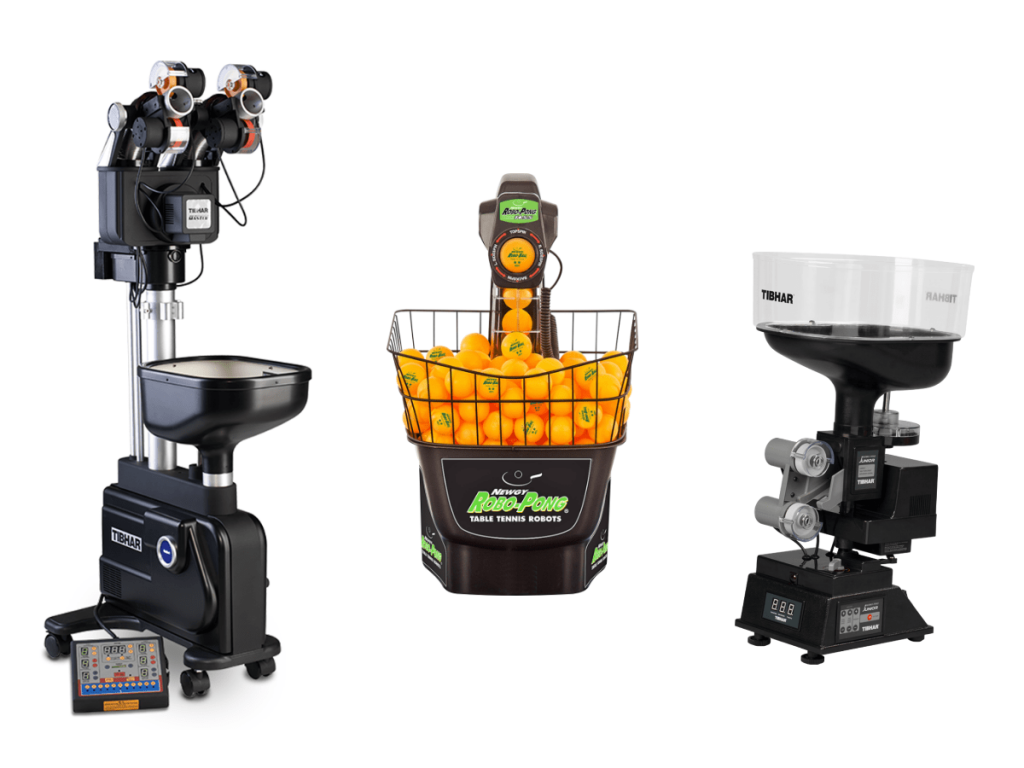
In the foreground for all those who consider to purchase a table tennis robot, is usually the desire for an improvement in the sport of table tennis. The acquisition of such a robot is not cheap and should be well considered.
A table tennis robot test of each individual ball machine in a retail store is difficult, because the device must be set up separately for this purpose. Often the stores are too small or have only one model, which is permanently built for testing rubbers or the like. But is just this device of the regional dealer exactly the right thing?
We from tt-shop.de are aware of this problem and have all table tennis robots from our assortment tested thoroughly and try to take away your inhibitions to buy a table tennis robot online with this report.
Table tennis robots with automatic ball return are a great thing, as they offer some advantages and are therefore not directly comparable to those without an automatic ball return.
With automatic ball return, the balls played are caught with a catch net and then collected by a return system as well as automatically guided back to the robot head, allowing continuous operation.
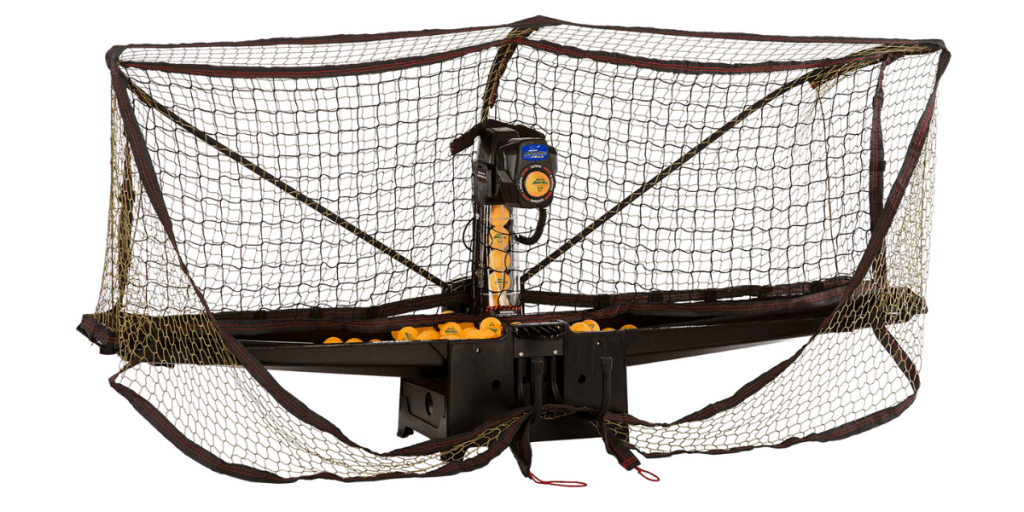
First place in our comparison goes to the Donic Robo Pong 2055 with a score of 1.3. In contrast to its predecessor (2050), the 2055 is now even more powerful and of higher quality. A different control unit (& modified electronics and new firmware and software) make the Robo Pong 2055 more reliable, faster and more accurate.
There are enough reasons for rank 1: The 2055 impresses with an acceptable price, which also includes the ball catching net and the automatic ball return. In addition, the Donic Robo Pong 2055 can be classified as quite high quality overall, and a variety of useful settings can be made via the control panel.
These include, for example, the ball speed of up to 120 km/h with 30 tempo settings, the ball output frequency of up to 170 balls/min, the high ball placement accuracy by means of 21 oscillator positions, 13 tilt angle settings and, of course, the spin intensity or spin direction. Topspin, undercut, sidecut (sidespin), counter, serve or push are available.
is also the menu guidance, which reacts quickly and is very understandably structured. There are also different languages to choose from with the Donic Robo Pong 2055. In the practice mode, 64 preset exercises can be accessed, along with the other settings, this table tennis robot can be used at all levels of play, whether for the rank beginner or the experienced club player.
Special bonus points and in sum the reason why they should buy this table tennis robot, brought the Donic Robo Pong 2055 the simple and quick assembly as well as disassemblyein. Comparable table tennis robots in this review have similarly good features and settings, but are significantly more expensive, which is why first place goes to the Donic Robo Pong 2055.
The 2nd place in our ranking cannot be clearly limited to one robot, as there are many different tastes. In any case, the following three robots share 2nd place in our test: the latest robot from Donic, the Donic Robo Pong 3050 XL, the Tibhar Robo Pro Genius and the Tibhar Robo Pro Master.
But why are these three models so close together? The reason is that it depends on what your preferences are. Do you want the latest of the latest, combined with high-tech of tomorrow already today?
Or do you look a little more at the money and you do not need such exclusivity? Or do you want a few more features? You see, it depends on you! A detailed description of the three robots will be given in the following sections. We focus on the most important criteria, which should make the decision easier for you.

Let’s start with the latest model of our runner-up, which comes from Donic: The Donic Robo Pong 3050 XL (grade 1.7). Who of you is into absolute know-how, high-tech, the latest of the latest?
Who wants to experience tomorrow’s technology today, so to speak? In that case, the 3050 XL would be absolutely right for you. An all-rounder that naturally has its price.
The 3050 XL can do what other TT robots cannot. That would be, in addition to the modern design, first of all the novel control and operation: Instead of a control console, this now works via the Newgy app (iOS or Android), e.g. with the smartphone or tablet, conveniently via Bluetooth. The associated menu is clear and intuitive to navigate.
In terms of functions, there are countless features that can be conveniently made via the screen: Ball speed, oscillator positions, spin type and strength, ball frequency/minute or the ball quantity. Also, over 100(!) pre-programmed exercises can be used or more can be created by yourself.
The 3050 XL has a fully automated rotary head and double ejection rollers (this allows different spin directions, regardless of the ball ejection speed). Many different positions can be set quickly and precisely, making varied training easy.
Lights on the robot give feedback on the type and strength of spin (or if certain settings are not possible). This is unique so far! Regarding the materials used and the material processing, the highest standards are set!
This, plus intelligent and high quality electronics, make the Robo Pong 3050XL a more reliable TT robot. All these features ensure that the 3050 XL creates an extremely game-like and real table tennis feeling, which is almost like playing with a real training partner. This delights the table tennis heart! Furthermore, a fairly simple assembly and disassembly and the good transport options stand out.
The hair in the soup is the high purchase price. One should be clear before buying how often this robot will be used. In addition, a safe storage zwischem games, as well as regular maintenance & Cleaning is mandatory.

Further as place 2 in our comparison of table tennis robots with automatic ball return is the Tibhar Robo Pro Genius to choose from. The overall score of 1.7 was not awarded in vain. However, the price of this really good robot is higher than that of the first-place Donic Robo Pong 2055.
We could not find significantly better features that would justify the higher price in our comparison. Both devices are similar in terms of playing possibilities.
Like the Donic Robo Pong 2055, the Tibhar Robo Pro Genius can be classified as high quality and the settings are also very versatile and sensible.
These even include playing direct and indirect balls, adjusting the ball flight curve, adjustable ball placement based on 11 preset table positions, and of course, configurable spin: game options include no spin, topspin, undercut, left and right spin, undercut with left or right spin, and topspin with left or right spin.
The whole thing is available for 10 adjustable ball speeds and 10 adjustable ball ejection frequencies (25 to 95 balls/min). However, these are less versatile than the 3050 XL (but the Genius is a lot cheaper).
If you want to buy this table tennis robot, you will get an absolutely clean, understandable and correctly working menu.
The Tibhar Robo Pro Genius works with a high level of precision and is quick to set up and take down. Transport options are limited, as the robot can be pushed easily using transport wheels, but is difficult to carry due to its heavy weight.
In summary, this leads to a justified, shared 2nd place in our test & comparison of table tennis robots based on the evaluated price-performance ratio.
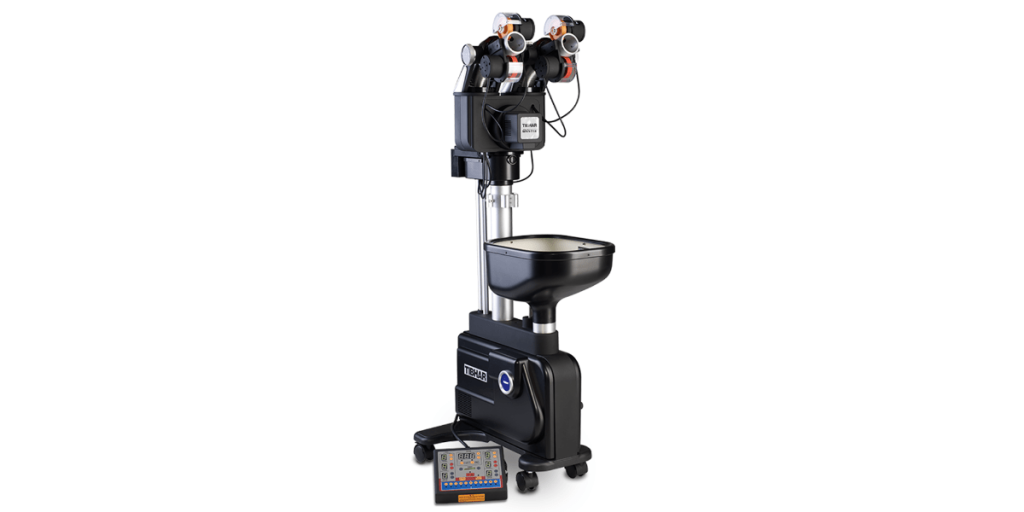
The third representative in the series of runners-up is the Tibhar Robo Pro Master. It is considerably more expensive than the Robo Pro Genius (a further development of the Genius), but at least it is still considerably cheaper than the 3050 XL, so it is a kind of price middle ground, so to speak.
If quality and functionality were the main criteria, this robot would be the clear number 1. However, the price-performance ratio was evaluated. Even if we are convinced by the device, the high purchase price compared to the Robo Pong 2055 is the reason for the “worse” rating.
As for the choice of settings and variants, this is unbeaten in the comparison of the four robots together with the 3050XL and is considered something like the non-plus-ultra (it has, for example, 2 ejection rollers!). However, one should keep in mind that the Tibhar Robo Pro Master is significantly more expensive than the Donic Robo Pong 2055 and still significantly more expensive than the Tibhar Robo Pro Genius.
Given these facts, we rank the Tibhar Robo Pro Master as a very solid 1.7 in our set of runners-up.
When it comes to buying table tennis robots, the wallet plays an important role for many clubs, but also for private individuals. Since we tested the price-performance ratio, this is the reason for the classification of this qualitatively very high-quality table tennis robot.
For those for whom money plays a rather subordinate role and who absolutely need the great features, the Tibhar Robo Pro Master, which by the way is the further development of the Tibhar Robo Pro Genius, is in any case optimally advised. Qualitatively, there is no doubt that our 3rd place is without flaw and without ifs and buts.
Assembling and disassembling the device is quick and easy. The setting options are worth seeing: two ball ejection heads are available, which means that topspin and undercut balls can be ejected alternately.
This is probably the feature par excellence that distinguishes the Tibhar Robo Pro Master from the other robots in this comparison. Furthermore, there are nine different cut types per head to choose from: Without any cut, with topspin, undercut, left and right spin, topspin with right and left spin, and undercut with right and left spin.
The balls of the Tibhar Robo Pro Master can be played in 10 speed levels and also in 10 ball ejection frequencies, these range from 25 to 95 balls/min. Direct and indirect balls are also available, as well as 11 ball placement positions and trajectory angle adjustability. The player has access to 30 pre-programmed exercises. For those for whom price is not the decisive criterion for buying a table tennis robot, this one is the best choice.
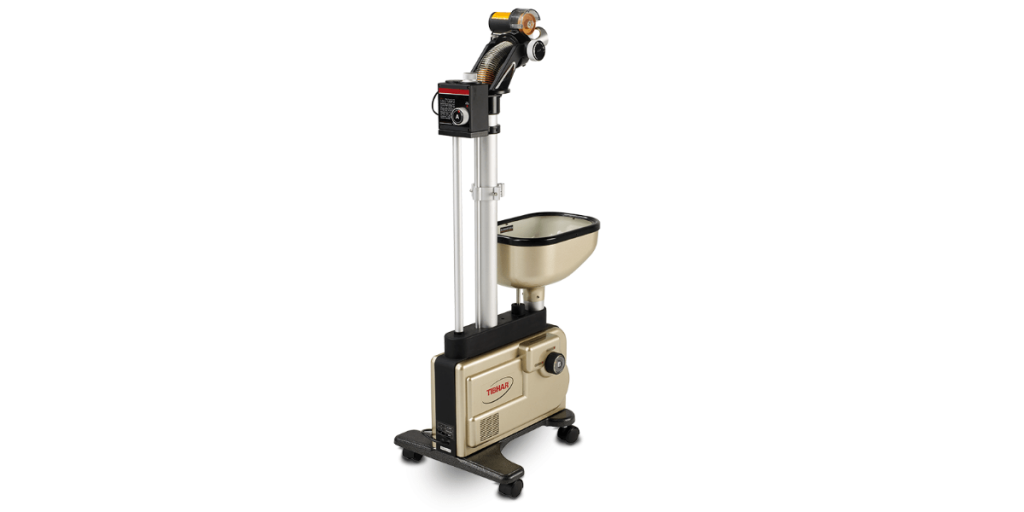
The last place is occupied by the Tibhar Robo Pro Plus with a solid score of 2.3. The reason for this is due to several factors: In terms of spin settings, only topspin and undercut balls can be played, which is a disadvantage given the rather high price, even though the Tibhar Robo Pro Plus has a ball catching net and automatic ball return.
Furthermore, this table tennis robot attracts attention from time to time by making quite loud noises. However, the workmanship is 1A.
There is also a series of advantages, after all, the Tibhar Robo Pro Plus is placed last in our test, but a note of 2.3 speaks yes also a clear, good language. Because the Tibhar Robo Pro Plus is very robust, durable, high-quality and precise. Many wear parts are available as spare parts.
Assembly and disassembly are easy. In addition, the robot has nine adjustable ball speeds and nine ball ejection frequencies with the head oscillator function available. Long or short balls can also be played. Therefore, the Tibhar Robo Pro Plus rightly joins our comparison of table tennis robots with a good score.
The following comparison includes those table tennis robots without automatic ball return. This means that the balls must be collected manually if there is no collection net and then placed in the robot’s collection tray so that it can return them.
For those who find the table tennis robots with automatic ball return too expensive, you can find some top recommendations in our comparison.
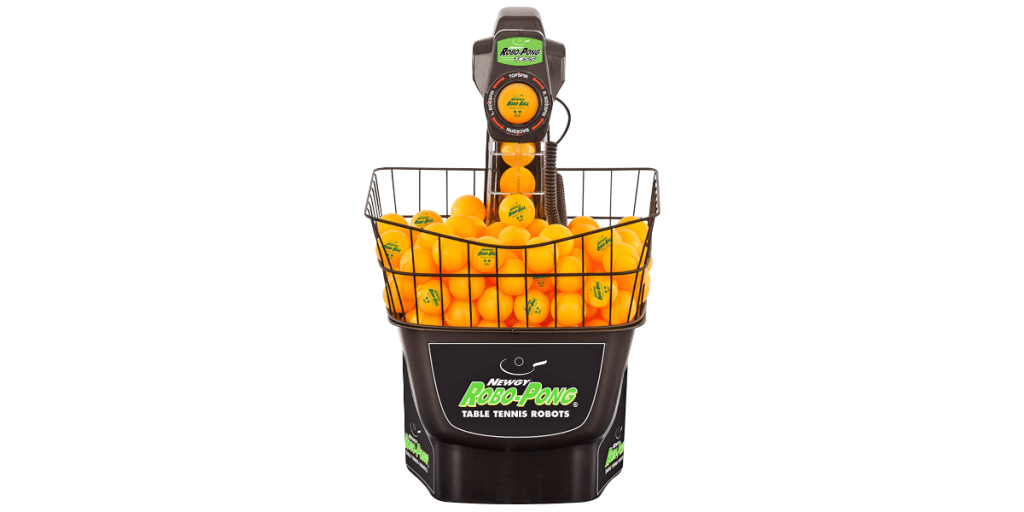
First place goes to the Donic Robo Pong 1055 with a score of 1.3. Unlike its predecessor, the Robo Pong 1050, the Robo Pong 1055 has new control unit electronics, i.e. new firmware and software.
This increases reliability and makes the robots faster at ball ejection than previous models. With a light and therefore easy-to-handle weight, the 1055 is also quick and easy to assemble and disassemble, as well as transport to another location.
The Donic Robo Pong 1055 is simply placed on the table and has quite a few adjustment options, while being very precise. These include about 21 oscillator positions, 13 head tilt angles, 30 ball speeds (up to 120 km/h), various ball ejection frequencies of up to 170 balls/min and 64 programmed exercises.
Especially positive: the catch tray includes 200 balls and these can be played as topspin, undercut, sidespin, counter, serve or push.
Due to these numerous settings, the Donic Robo Pong 1055 is certainly suitable as a training aid for beginners, but also for far advanced players!
Except for the automatic ball return, the Donic Robo Pong 1055 is technically the same as the Donic Robo Pong 2055. We found these settings very convincing in both categories – with and without automatic ball return – especially in connection with the price.
So our concrete product recommendation for all those who want to buy a table tennis robot is the Donic Robo Pong (either the 2055 or 1055 version, depending on your needs).
There are minor deductions with this device, as the Donic Robo Pong 1055 does not have a ball catching net, but this does not affect its superior functions.
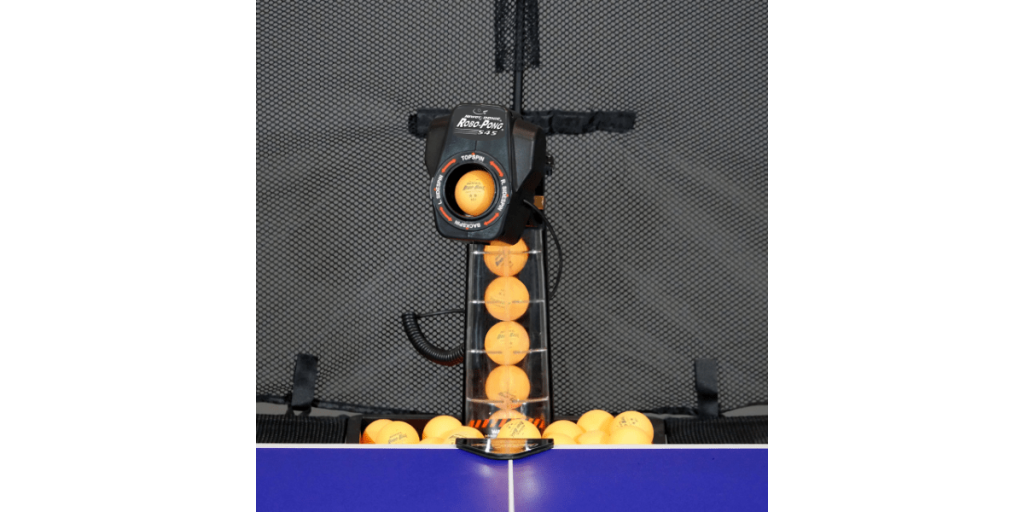
Rank 2 goes with a score of 2.0 to the Donic Robo Pong 545. Officially, this table tennis robot is considered Donic’s entry-level model.
However, it can already do a lot more. This robot has a good price-performance ratio, which can be an important criterion when buying a table tennis robot.
The Robo Pong 545 is the revised version of its predecessor (the Robo Pong 540), and is equipped with improved control unit and new AIM function:
Therefore, the adjustment of the robot head can now be done manually. Thus, the balls can be played on up to 3 different positions, such as backhand, forehand or middle.
The Donic Robo Pong 545 is placed variably on the table. Even though the price is quite low in view of the good setting options and quality, sidespin and undercut balls are provided with quite a pronounced cut.
This could be a bit difficult for beginners at times, with topspin again being rather moderately adjustable. Nevertheless, the Donic Robo Pong 545 deservedly lands in second place in our test of table tennis robots without ball return.
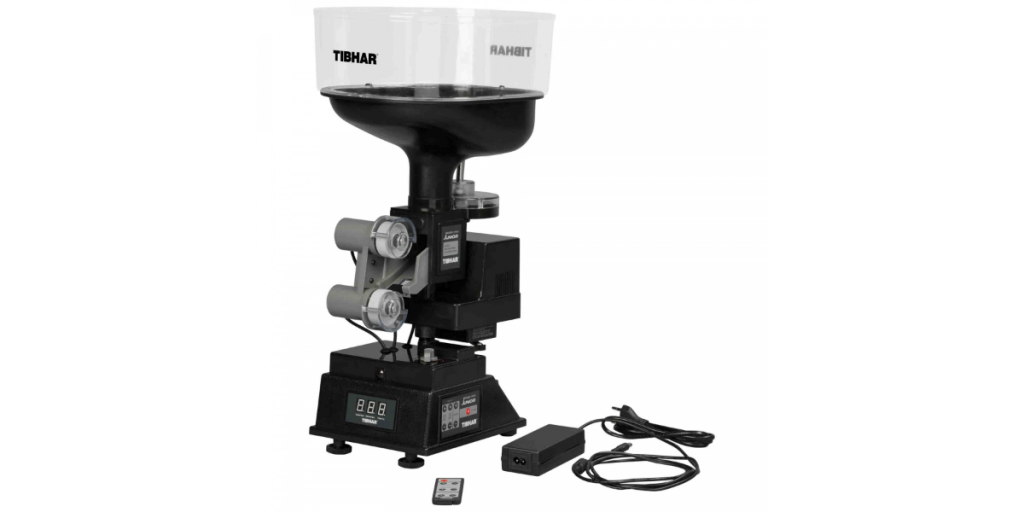
The most difficult decision regarding the evaluation of the price/performance ratio had to be made with the Tibhar Robo Pro Junior.
The model offers both the possibility of the cut variation, as well as different placements to play. The functionality offers limitations compared to the Robo Pong 1055 and the Joola Shorty, but the price is more affordable than the Robo Pong 545.
The Tibhar Robo Pro Junior was created by Tibhar to offer competition to the TT Buddy models from Joola. While it is a bit more expensive than the Buddys, it has a clear advantage in terms of reliability, placement options and build quality.
At the end of the day, we decided on the #3 spot with an overall score of 2.3. This is due to several reasons that were particularly noticeable in our comparison:
The Tibhar Robo Pro Junior is cheaper than the Donic Robo Pong 545 and significantly cheaper than the Joola Shorty (4th place). Topspin and undercut balls can be played with high precision. The ball capacity is identical to the 545 model.
Only the “sidespin” adjustment option is missing from the Robo Pro Junior, so it can’t quite compete with the Donic model. Those who feel connected to the Tibhar brand and do not need this adjustment should buy the Tibhar Robo Pro Junior.
The robot can be placed anywhere on the table and is relatively easy to set up as well as take down. With 100 balls fitting into the collection tray, it is a reasonable size. Also, it is quite light and therefore easily transportable, furthermore, it impresses with a good precision. The device is intended especially for children and beginners (but also advanced).

4th place among the ball robots without feedback system goes to the Joola Shorty with a score of 2.4. Purely in terms of settings and practical usability, the Joola Shorty is really well positioned:
Trajectory, 8 ball speeds, spread angle, a 9-step ball ejection frequency (25-85 balls/min) and 8 rotation shapes of the balls (topspin, undercut and sidecut combinations) are adjustable. An oscillator function as well as direct and indirect balls are playable, and the ball tray even includes 150 balls.
Assembly and disassembly is relatively easy, but a bit of time is required to put on the ball tray and screw on the ball mixing rod. So far, so good.
But in our comparison of table tennis robots, the very high acquisition costs for the Joola Shorty still stand out, where other robots in this price category simply have similar settings and are still significantly cheaper and therefore graded better.
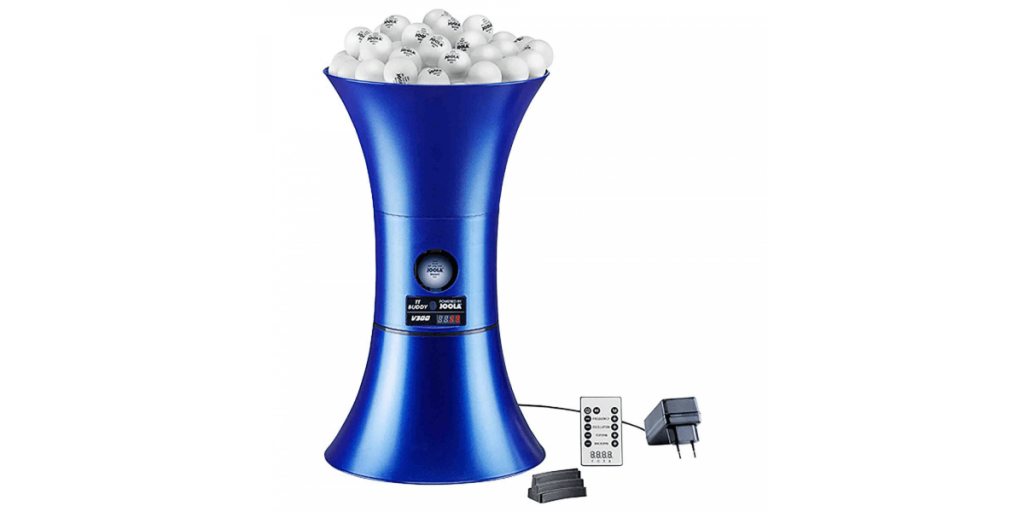
With a score of 3.3 in our comparison, fifth place goes to the Joola TT Buddy V300. Let’s start with the positive aspects: First, of course, the favorable purchase price catches the eye. Also the weight of just 1.1 kg is very advantageous, just like the super fast assembly and disassembly.
In keeping with the low price, the adjustment options are of course limited: There are 2 ball ejection frequencies (20 or 70 balls/min), 5 levels for topspin and undercut balls (with 2 topspin intensities adjustable), and an oscillator function.
However, there are a few downsides to the Joola TT Buddy V300 that ultimately led to its rear ranking and that you should be aware of if you want to buy this table tennis robot.
First of all, this includes the fact that the balls can only be ejected at quite high speeds, newcomers do not always find this good. Balls also like to get stuck once, which is extremely annoying for the game operation. Furthermore, you have to accept losses in terms of precision with the Joola TT Buddy V300:
Even with the same position of the head, the balls arrive at sometimes quite different places on the table. Therefore, it should be carefully considered how the Joola TT Buddy V300 should be used.
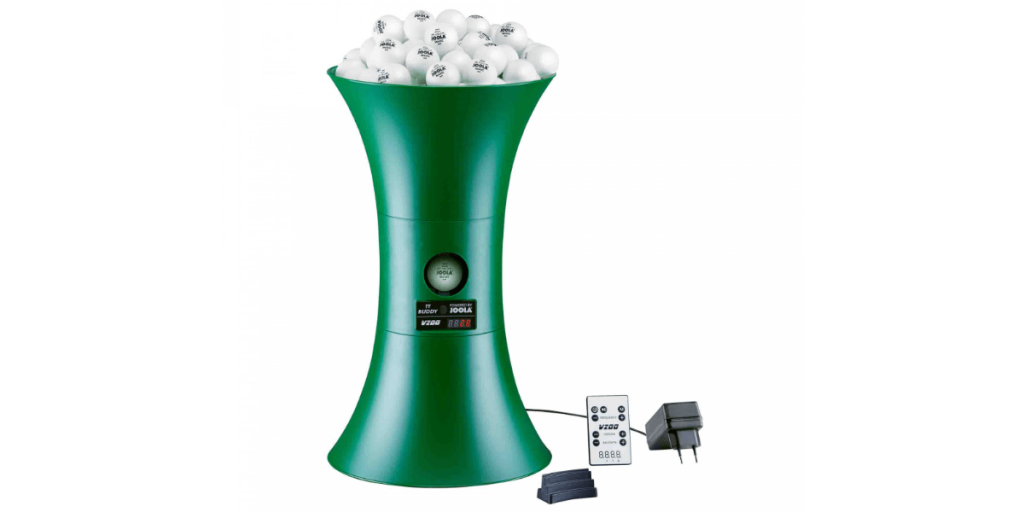
The 6th place in our comparison of table tennis robots goes to the Joola TT Buddy V200. In terms of pros and cons for buying a table tennis robot, they are very similar to the Joola TT Buddy V300, but the V200 is even cheaper. However, it does not have an oscillator function and the speeds of the balls are not adjustable in steps.
In addition, it only has one topspin and one undercut intensity setting each. Since, as mentioned above, the problems with lack of ball precision and slight susceptibility to balls getting stuck persist, the Joola TT Buddy V200 only gets a score of 3.7.
We conclude that while this table tennis robot is very inexpensive to purchase, meaningful and equally long-term training in the area of motivated players is only possible to an extremely limited extent. Therefore, the Joola TT Buddy V200 is more suitable for home use or for example for selective use in physical education.
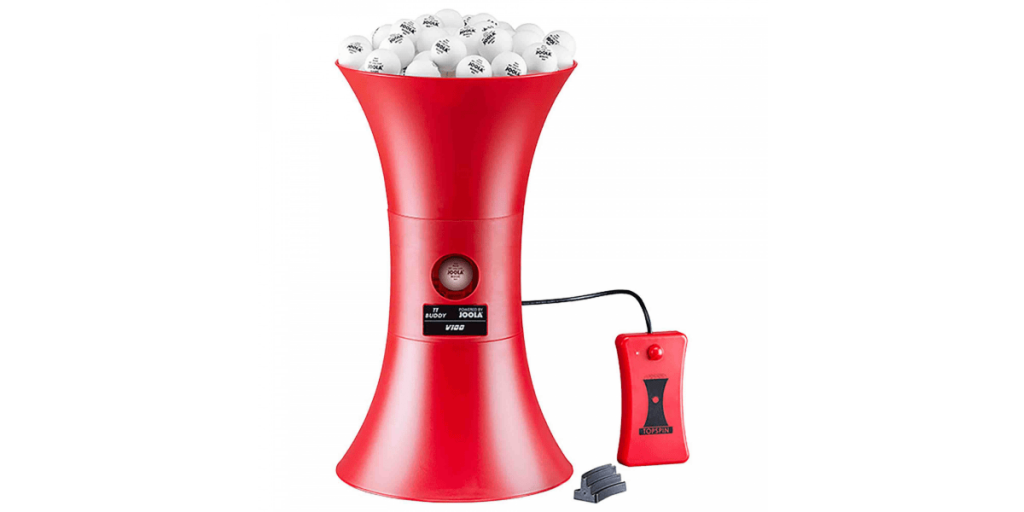
The last place in our comparison of table tennis robots goes to the basic version of the Joola TT Buddy series, the Joola TT Buddy V100. Like its brothers, the Joola TT Buddy V200 and V300, it is equally super quick to set up and at around 1.1kg is also very light and handy.
100 balls fit in the collection tray, which is absolutely ok. This table tennis robot is also simply placed on the table in any position and off you go. However, in terms of playing the Joola TT Buddy V100, there are a lot of limitations:
The balls are only ejected with topspin (no undercut!). Only the ball ejection frequency can be adjusted.
There is also no oscillator function and only one ejection speed. With these limited setting options, the very reasonable purchase price offers little consolation. Especially since the Joola TT Buddy V100 is not free of the problems of the V200 and V300 (poor ball precision, sometimes stuck balls).
We can therefore only recommend the Joola TT Buddy V100 for children’s birthday parties, home use and or similar. A training-scientifically meaningful and long-term integration into the club everyday life we do not see (unfortunately). Finally, this is also reflected in the grade (4.0) with which our comparison of table tennis robots ends.
You should not buy this table tennis robot if you have high demands on the athletic development of the player who is to play with this device. Nevertheless, it is not bad for home use in the hobby sector & very cheap!
To sum up: Table tennis robots are a great invention and as part of the training for both beginners to club players to be considered a meaningful addition. This is because robot training offers some advantages that cannot be achieved with a flesh and blood training partner.
On the other hand, it is also the other way around, so that table tennis robots always only complement, but never replace, training with a partner.
In our comparison of table tennis robots, we have made a division into robots with automatic ball return (this saves an enormous amount of time, lets you train longer at a stretch and the balls get dirty less or hardly need to be collected) and robots without automatic ball return.
For robots without ball return net, it is recommended to purchase one in addition. All robots have in common that they should be maintained, cared for and cleaned every now and then so that they work well and as precisely as possible for a long time. Below, our rankings are once again summarized as an overview for you.
One thing you should know, though. The rankings are in no way a devaluation of the products. Rather, it is a ranking of different types of products that are suitable for different purposes and different fields of application.
Each of these devices has its raison d’être and enjoys a good demand, so ultimately you decide which table tennis robot is best suited for your individual needs.

Grade 1.3
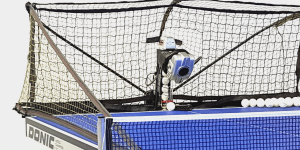
Grade 1.7
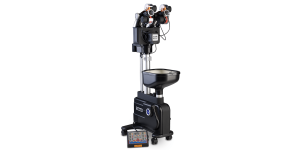
Grade 1.7
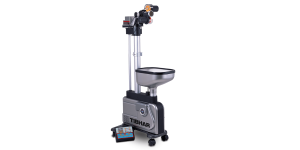
Grade 1.7
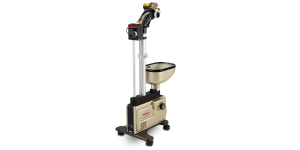
Grade 2.3
Note: The price-performance ratio was tested. If you want to buy the current best quality, so our recommendation is the Tibhar Robo Pro Master! The workmanship is top, Tibhar offers a competent service center for technical problems (which almost never occur) and the robot can alternately bring in backspin and topspin.
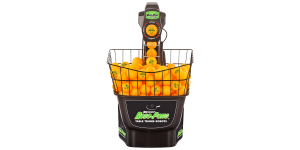
Grade 1.3

Grade 2.0
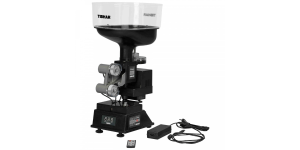
Grade 2.3
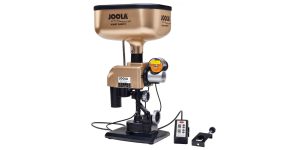
Grade 2.4
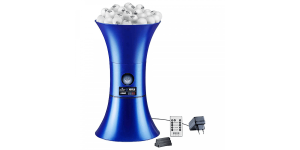
Grade 3.3
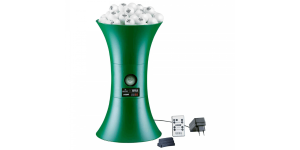
Grade 3.7
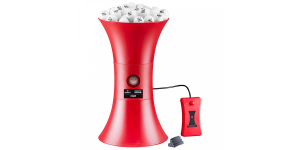
Grade 4.0
Note: The price-performance ratio was also tested here. The intended use for clubs was assumed. For home use, especially by ambitious beginners, we recommend the Tibhar Robo Pro Junior (bottom or top cut) or the Donic Robo Pong 545 (side cut also possible).
The TT Buddys from Joola are also not bad for this small price, as long as you do not have higher demands on the precision of the ball play and can live with small technical quirks. With these devices, you just have to move to the ball accordingly well before each shot :-).
After we have presented many robots in our big test report, we would like to give some short basic information about the ball machines to help those who are still undecided. Table tennis robots are sports devices placed on or behind the table tennis table, which play table tennis balls automatically in the direction of the opponent’s half of the table after corresponding inputs on the control unit.
Depending on the type and device, different settings (e.g. placement, speed, rotation strength and direction, frequency, …) can be undertaken.
Table tennis robots consist of important core elements, these include for example: control unit (used for setting and overall operation of the robot), head (used for output of balls), ball hopper and, if available, a ball catching net or even an automatic ball return, which allows continuous operation.
Nowadays, there is quite a wide range of table tennis robots. What advantages and disadvantages they offer, and which ones we recommend, will be discussed in more detail below.
Table tennis robots offer a lot of useful advantages, but also some disadvantages that everyone should be aware of. Because such robots can never replace a real training partner made of flesh and blood. In training, but also in competition, it is important to learn to interpret the opponent’s hand and racket movements, for example, to recognize the spin intensity of the ball and to react optimally.
This is of course not possible with table tennis robots, nor can they replicate the high range of spin intensities that a real player is capable of playing, or only to a limited extent. However, if one is aware of these disadvantages and adds robot training, there is nothing to be said against it.
Because table tennis robots also have a lot of advantages: Due to automation, ball bucket training with a ball giver is no longer necessary. The robot now takes care of that. Coaches can thus look at and analyze the player much more intensively.
If a catch net is available, by far not so many balls have to be searched for and collected, which saves a lot of time! Furthermore, especially with robots with automatic ball return, certain exercises and ball combinations can be played through for a very long time, which trains endurance to a particular extent and also the repeatability of certain strokes and techniques.
Another advantage is that footwork can also be trained very well with table tennis robots.
Before coming to the decision whether to buy a table tennis robot or not, everyone should decide for themselves whether it makes sense or not. Our recommendation is that a robot should be bought only if it will be used regularly and in the long term.
Now that we have written down criteria and test results to help you buy the right table tennis robot for you, you should finally consider the following tips.
After buying a table tennis robot that exactly fits the particular requirements of the target group or person, the joy is of course always great.
Many new things are discovered and can now be carried out, whether privately at home, or in the club. However, all table tennis robots, whether with premium quality, such as the Donic Robo Pong 2055 or the Donic Robo Pong 1055, or as a simple ball robot have something in common:
They want to be maintained. In this regard, we want to give you a few tips on the way. These refer, for example, to the conveying elements of the balls, such as the conveying wheels/rollers or also the head, the collecting trays etc..
These should be cleaned and serviced every so often. Dirt in or on these parts can sometimes cause balls to jam and endanger the precision and longevity of the table tennis robot. Of course, the same applies to the balls themselves: if they come into contact with dirt from the hall or basement floor, you literally carry this dirt into the table tennis robot and restrict its functionality. Therefore, the balls should also be cleaned regularly to avoid this. What helps well in this regard is the additional purchase of a ball catching net.
If this is not already included, one should certainly think about it. Ball catching nets prevent the majority of balls from falling to the floor (note: don’t forget to buy enough balls). By the way: the tables can also get dirty relatively quickly. So make sure they are clean as well! Also important: if a ball does get stuck, then please never bump or hit the table tennis robot, this could damage it permanently.
With these tips you will have a lot of fun and success with your table tennis robot. Have fun with your new table tennis robot!
By the way, if you have any questions, please feel free to comment on this post. I would be happy if you would not only use this page as a source of information, but buy your table tennis robot here in the TT Shop.
Many greetings from the author, Matthias Bormann

As a qualified sports scientist and table tennis coach I blog here about the most important topics in table tennis, the table tennis material & my TT store.

As a qualified sports scientist and table tennis coach I blog here about the most important topics in table tennis, the table tennis material & my TT store.